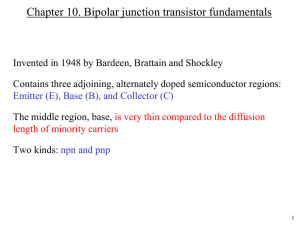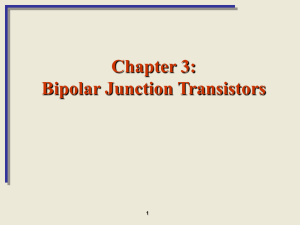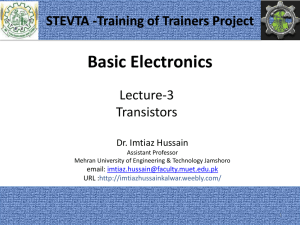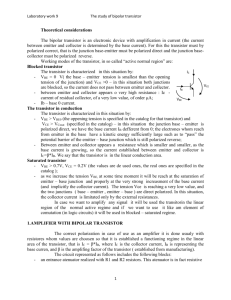edc transistor
advertisement
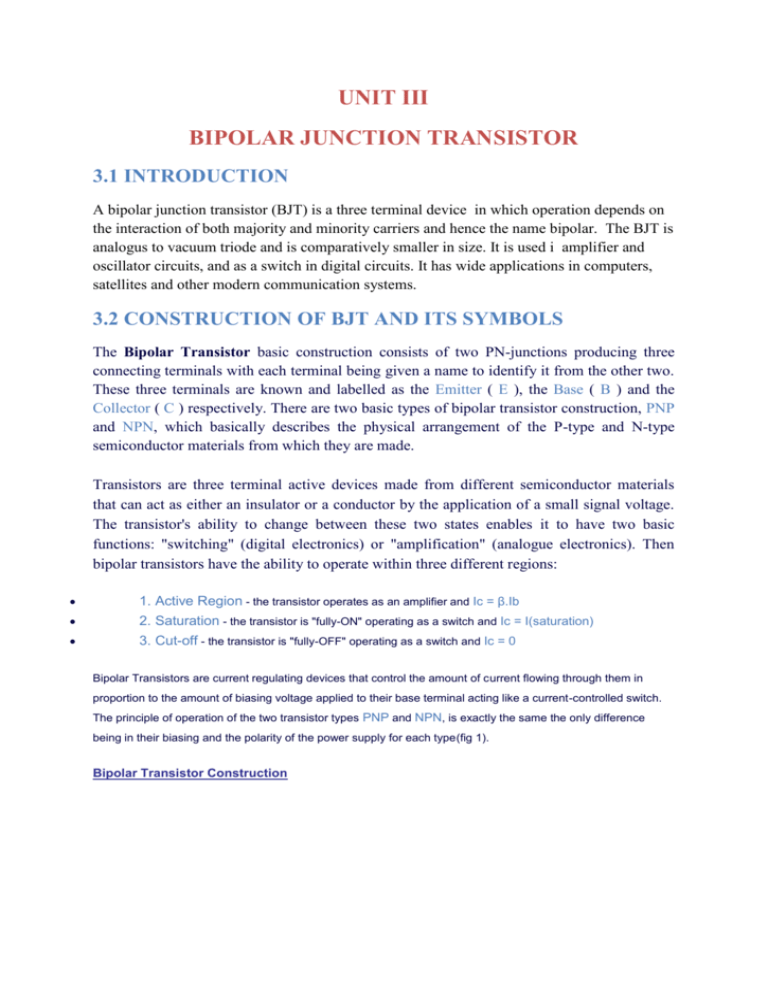
UNIT III BIPOLAR JUNCTION TRANSISTOR 3.1 INTRODUCTION A bipolar junction transistor (BJT) is a three terminal device in which operation depends on the interaction of both majority and minority carriers and hence the name bipolar. The BJT is analogus to vacuum triode and is comparatively smaller in size. It is used i amplifier and oscillator circuits, and as a switch in digital circuits. It has wide applications in computers, satellites and other modern communication systems. 3.2 CONSTRUCTION OF BJT AND ITS SYMBOLS The Bipolar Transistor basic construction consists of two PN-junctions producing three connecting terminals with each terminal being given a name to identify it from the other two. These three terminals are known and labelled as the Emitter ( E ), the Base ( B ) and the Collector ( C ) respectively. There are two basic types of bipolar transistor construction, PNP and NPN, which basically describes the physical arrangement of the P-type and N-type semiconductor materials from which they are made. Transistors are three terminal active devices made from different semiconductor materials that can act as either an insulator or a conductor by the application of a small signal voltage. The transistor's ability to change between these two states enables it to have two basic functions: "switching" (digital electronics) or "amplification" (analogue electronics). Then bipolar transistors have the ability to operate within three different regions: 1. Active Region - the transistor operates as an amplifier and Ic = β.Ib 2. Saturation - the transistor is "fully-ON" operating as a switch and Ic = I(saturation) 3. Cut-off - the transistor is "fully-OFF" operating as a switch and Ic = 0 Bipolar Transistors are current regulating devices that control the amount of current flowing through them in proportion to the amount of biasing voltage applied to their base terminal acting like a current-controlled switch. The principle of operation of the two transistor types PNP and NPN, is exactly the same the only difference being in their biasing and the polarity of the power supply for each type(fig 1). Bipolar Transistor Construction Fig:1 The construction and circuit symbols for both the PNP and NPN bipolar transistor are given above with the arrow in the circuit symbol always showing the direction of "conventional current flow" between the base terminal and its emitter terminal. The direction of the arrow always points from the positive P-type region to the negative Ntype region for both transistor types, exactly the same as for the standard diode symbol. 3.3 TRANSISTOR CURRENT COMPONENTS: FIG 2 The above fig 2 shows the various current components, which flow across the forward biased emitter junction and reverse- biased collector junction. The emitter current IE consists of hole current IPE (holes crossing from emitter into base) and electron current InE (electrons crossing from base into emitter).The ratio of hole to electron currents, IpE / InE , crossing the emitter junction is proportional to the ratio of the conductivity of the p material to that of the n material. In a transistor, the doping of that of the emitter is made much larger than the doping of the base. This feature ensures (in p-n-p transistor) that the emitter current consists an almost entirely of holes. Such a situation is desired since the current which results from electrons crossing the emitter junction from base to emitter does not contribute carriers, which can reach the collector. Not all the holes crossing the emitter junction JE reach the the collector junction JC Because some of them combine with the electrons in n-type base. If IpC is hole current at junction JC there must be a bulk recombination current ( IPE- IpC ) leaving the base. Actually, electrons enter the base region through the base lead to supply those charges, which have been lost by recombination with the holes injected in to the base across J E. If the emitter were open circuited so that IE=0 then IpC would be zero. Under these circumstances, the base and collector current IC would equal the reverse saturation current ICO. If IE≠0 then IC= ICO- IpC For a p-n-p transistor, ICO consists of holes moving across JC from left to right (base to collector) and electrons crossing JC in opposite direction. Assumed referenced direction for ICO i.e. from right to left, then for a p-n-p transistor, ICO is negative. For an n-p-n transistor, ICO is positive.The basic operation will be described using the pnp transistor. The operation of the pnp transistor is exactly the same if the roles played by the electron and hole are interchanged. One p-n junction of a transistor is reverse-biased, whereas the other is forward-biased. Forward-biased junction of a pnp transistor Reverse-biased junction of a pnp transistor Both biasing potentials have been applied to a pnp transistor and resulting majority and minority carrier flows indicated. Majority carriers (+) will diffuse across the forward-biased p-n junction into the n-type material. A very small number of carriers (+) will through n-type material to the base terminal. Resulting IB is typically in order of microamperes. The large number of majority carriers will diffuse across the reverse-biased junction into the ptype material connected to the collector terminal Applying KCL to the transistor : I E = IC + IB The comprises of two components – the majority and minority carriers IC = ICmajority + ICOminority ICO – IC current with emitter terminal open and is called leakage current Various parameters which relate the current components is given below Emitter efficiency: currentofinjectedcarriersatJ E totalemittercurrent I pE I PE I pE I nE I nE Transport Factor: * injectedcarriercurre ntreachingJ C injectedcarrierncurr entatJ E * I pC I nE Large signal current gain: The ratio of the negative of collector current increment to the emitter current change from zero (cutoff)to IE the large signal current gain of a common base transistor. ( I C I CO ) IE Since IC and IE have opposite signs, then α, as defined, is always positive. Typically numerical values of α lies in the range of 0.90 to 0.995 I pC IE I pC I nE * I pE IE * The transistor alpha is the product of the transport factor and the emitter efficiency. This statement assumes that the collector multiplication ratio * is unity. * is the ratio of total current crossing JC to hole arriving at the junction. 3.4 Bipolar Transistor Configurations As the Bipolar Transistor is a three terminal device, there are basically three possible ways to connect it within an electronic circuit with one terminal being common to both the input and output. Each method of connection responding differently to its input signal within a circuit as the static characteristics of the transistor vary with each circuit arrangement. 1. Common Base Configuration - has Voltage Gain but no Current Gain. 2 Common Emitter Configuration - has both Current and Voltage Gain. 3. Common Collector Configuration - has Current Gain but no Voltage Gain. 3.5 COMMON-BASE CONFIGURATION Common-base terminology is derived from the fact that the : base is common to both input and output of t configuration. base is usually the terminal closest to or at ground potential. Majority carriers can cross the reverse-biased junction because the injected majority carriers will appear as minority carriers in the n-type material. All current directions will refer to conventional (hole) flow and the arrows in all electronic symbols have a direction defined by this convention. Note that the applied biasing (voltage sources) are such as to establish current in the direction indicated for each branch. To describe the behavior of common-base amplifiers requires two set of characteristics: 1. Input or driving point characteristics. 2. Output or collector characteristics The output characteristics has 3 basic regions: Active region –defined by the biasing arrangements Cutoff region – region where the collector current is 0A Saturation region- region of the characteristics to the left of VCB = 0V The curves (output characteristics) clearly indicate that a first approximation to the relationship between IE and IC in the active region is given by IC ≈IE Once a transistor is in the ‘on’ state, the base-emitter voltage will be assumed to beVBE = 0.7V In the dc mode the level of IC and IE due to the majority carriers are related by a quantity called alpha = αdc IC = IE + ICBO It can then be summarize to IC = IE (ignore ICBO due to small value) For ac situations where the point of operation moves on the characteristics curve, an ac alpha defined by αac Alpha a common base current gain factor that shows the efficiency by calculating the current percent from current flow from emitter to collector. The value of is typical from 0.9 ~ 0.998. Biasing:Proper biasing CB configuration in active region by approximation IC IE (IB 0 uA) 3.6 TRANSISTOR AS AN AMPLIFIER Common-Emitter Configuration It is called common-emitter configuration since : emitter is common or reference to both input and output terminals.emitter is usually the terminal closest to or at ground potential. Almost amplifier design is using connection of CE due to the high gain for current and voltage. Two set of characteristics are necessary to describe the behavior for CE ;input (base terminal) and output (collector terminal) parameters. Proper Biasing common-emitter configuration in active region IB is microamperes compared to miliamperes of IC. IB will flow when VBE > 0.7V for silicon and 0.3V for germanium Before this value IB is very small and no IB. Base-emitter junction is forward bias Increasing VCE will reduce IB for different values. Output characteristics for acommon-emitter npn transistor For small VCE (VCE < VCESAT, IC increase linearly with increasing of VCE VCE > VCESAT IC not totally depends on VCE constant IC IB(uA) is very small compare to IC (mA). Small increase in IB cause big increase in IC IB=0 A ICEO occur. Noticing the value when IC=0A. There is still some value of current flows. Beta () or amplification factor The ratio of dc collector current (IC) to the dc base current (IB) is dc beta (dc ) which is dc current gain where IC and IB are determined at a particular operating point, Q-point (quiescent point). It’s define by the following equation: 30 < dc < 300 2N3904 On data sheet, dc=hfe with h is derived from ac hybrid equivalent cct. FE are derived from forward-current amplification and common-emitter configuration respectively. For ac conditions, an ac beta has been defined as the changes of collector current (IC) compared to the changes of base current (IB) where IC and IB are determined at operating point. On data sheet, ac=hfe It can defined by the following equation: From output characteristics of commonemitter configuration, find ac and dc with an Operating point at IB=25 A and VCE =7.5V Relationship analysis between α and β 3.7 COMMON – COLLECTOR CONFIGURATION Also called emitter-follower (EF). It is called common-emitter configuration since both the signal source and the load share the collector terminal as a common connection point.The output voltage is obtained at emitter terminal. The input characteristic of common-collector configuration is similar with common-emitter. configuration.Common-collector circuit configuration is provided with the load resistor connected from emitter to ground.It is used primarily for impedance-matching purpose since it has high input impedance and low output impedance. For the common-collector configuration, the output characteristics are a plot of IE vs VCE for a range of values of IB. Limits of opearation Many BJT transistor used as an amplifier. Thus it is important to notice the limits of operations.At least 3 maximum values is mentioned in data sheet. There are: a) Maximum power dissipation at collector: PCmax or PD b) Maximum collector-emitter voltage: VCEmax sometimes named as VBR(CEO) or VCEO. c) Maximum collector current: ICmax There are few rules that need to be followed for BJT transistor used as an amplifier. The rules are: transistor need to be operate in active region! IC < ICmax PC < PCmax Note: VCE is at maximum and IC is at minimum (ICMAX=ICEO) in the cutoff region. IC is at maximum and VCE is at minimum (VCE max = Vcesat = VCEO) in the saturation region. The transistor operates in the active region between saturation and cutoff. Refer to the fig. Example; A derating factor of 2mW/°C indicates the power dissipation is reduced 2mW each degree centigrade increase of temperature. Step1: The maximum collector power dissipation, PD=ICMAX x VCEmax= 18m x 20 = 360 mW Step 2: At any point on the characteristics the product of and must be equal to 360 mW. Ex. 1. If choose ICmax= 5 mA, substitute into the (1), we get VCEmaxICmax= 360 mW VCEmax(5 m)=360/5=7.2 V Ex.2. If choose VCEmax=18 V, substitute into (1), we get VCEmaxICmax= 360 mW (10) ICMAX=360m/18=20 mA Derating PDmax PDMAX is usually specified at 25°C. The higher temperature goes, the less is PDMAX Example;A derating factor of 2mW/°C indicates the power dissipation is reduced 2mW each degree centigrade increase of temperature.


